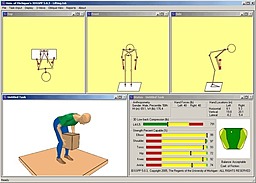3D Static Strength Prediction Program (3DSSPP)
TECHNOLOGY NUMBER: 0269
Tags:

Effective October 7, 2020 the University of Michigan has entered into an exclusive licensing arrangement with VelocityEHS | Humantech for forward licensing, support and development of the 3D Static Strength Prediction Program (3DSSPP). All forward sales, support and development of the program will be managed by the VelocityEHS | Humantech team. Additional information is available through their website.
OVERVIEW
Predicts level of exertion required for common tasks early in workspace design process
- Software can be tailored to fit different initial predicted postures
- Training available
BACKGROUND
3D SSPP software predicts static strength requirements for tasks such as lifts, presses, pushes, and pulls. The program provides an approximate job simulation that includes posture data, force parameters and male/ female anthropometry. Output includes the percentage of men and women who have the strength to perform the described job, spinal compression forces, and data comparisons to NIOSH guidelines. The user can analyze torso twists and bends and make complex hand force entries. Analysis is aided by an automatic posture generation feature and three-dimensional human graphic illustrations.
ADDITIONAL DETAILS
3D SSPP can be used as an aid in the evaluation of the physical demands of a prescribed job. Furthermore, the 3D SSPP can aid the analyst in evaluating proposed workplace designs and redesigns prior to the actual construction or reconstruction of the workplace or task. The program is applicable to worker motions in three dimensional space. 3D SSPP is most useful in the analysis of the “slow” movements used in heavy materials handling tasks since the biomechanical computations assume that the effects of acceleration and momentum are negligible. Such tasks can be evaluated best by breaking the activity down into a sequence of static postures and analyzing each individual posture. The 3D SSPP assumes the analyst understands the application of the NIOSH design and upper limit criteria for strength and disc compression forces (refer to Appendix III for details). The program should not be used as the sole determinant of worker strength performance or job designs based on that performance. Other criteria and professional judgement are required to properly design a safe and productive job.